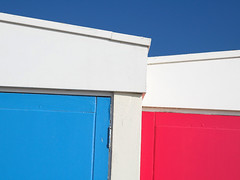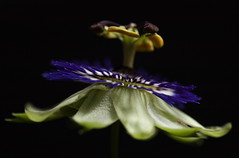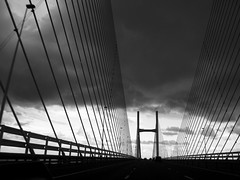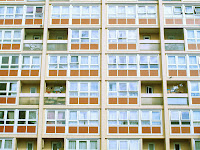
Nevpics
A photo blog by James Chudley
Monday, March 28, 2011
Moon rising at Stanton Drew

Friday, March 18, 2011
Buy a print for Comic relief
Monday, September 21, 2009
Principles of photography - Leading lines

Heather at Worms Head
Originally uploaded by Nevoir.
 A classic use of a leading line guiding the eye up to the Arc de Triomphe with some added jazz courtesy of the long exposure.
A classic use of a leading line guiding the eye up to the Arc de Triomphe with some added jazz courtesy of the long exposure. Another classic leading line, this time with a bit of a curve for added interest all leading to the old Cammel Laird ship yard on the banks of the mersey.
Another classic leading line, this time with a bit of a curve for added interest all leading to the old Cammel Laird ship yard on the banks of the mersey. A less conventional leading line but the same effect of giving the image depth is achieved. In this example the sense of depth is amplified by the shallow depth of field.
A less conventional leading line but the same effect of giving the image depth is achieved. In this example the sense of depth is amplified by the shallow depth of field.Tuesday, August 04, 2009
Principles of Photography - Simplicity

beach huts
Originally uploaded by Nevoir.
Monday, July 27, 2009
Sources of photographic inspiration

Spirals
Originally uploaded by Nevoir.
I often hear how fellow photographers are going through a dry patch of feel that everything they are taking is rubbish.
It’s the photographers equivalent of the yips. You seem to have lost the ability to see like a photographer and it’s a frustrating experience.
Here’s a few ways that I’ve managed to escape the yips in the past that you might find useful.
Flickr – By joining groups and widening your network on flickr you will continually see great photographs by you peers. This feeling of community is great for getting feedback and encouragement as well as ideas for new ways of shooting.
Podcasts – Do a search on iTunes and you’ll find loads of photo podcasts. I love the Magnum in Motion podcasts. There is something special about seeing photos put to music and a narrative. Try some of these top photo podcasts to brighten up your commute tomorrow.
Magazines – There are loads of photo mags out there and after subscribing to a few I noticed how they seem to recycle the same old articles. They are great however for giving you ideas for photo projects. It may be just what you need to get you back out there.
Books – Just yesterday I picked up “Earth from the air” by Jann Arthus-Bertrand and immediately wanted to grab my camera and head for the hills. Sometimes it’s too easy to forget how inspiring great photos can be.
Get printing – A classic symptom of the digital age is not bothering to print your pictures. Get yourself down IKEA, get some ribba frames and frame up some photos and stand back and admire your photos.
Exhibitions – Exhibitions are great because they often make you realise that you are better than you think! Set yourself that challenge of doing an exhibition in local cafe. Its cheaper and easier than you think and a great learning experience.
DVD’s – After getting the David Noton and Strobist DVD’s I’ve realised what a brilliant medium they are for learning. People learn in different ways but scan YouTube for snippets to see if they work for you.
Expert tuition – I’ve tried a few courses that have ranged from the wonderful “Lakeland Photo Holidays” to rubbish local one run by a wedding photographer who clearly wasn’t interested. These courses can work out expensive but can often push you in a different creative direction and its always refreshing to meet fellow photographers.
Fellow photographers - I'm sure that every photographer has hit a brick wall at some point. Speak to your photo mates and see what has got them out of the doldrums. You may have a favourite photographer to whom you can turn to for inspiration. Check out their latest work and see if it sparks some ideas.
Get shooting – All too often I go out to take some shots and get frustrated that what I’m shooting is rubbish. I think you've got to give yourself a chance as it takes a while to start seeing as a photographer again. Treat it as a warm up. Accept that you will take some rubbish but you if get at least one that’s a keeper then its a case of job done.
If you are stuck in a rut try one of these ideas and let me know if it worked for you!
Tuesday, July 21, 2009
RAW (good god) What is it good for? Absolutely everything

2. Correct images without losing throwing away quality
Or read this comprehensive review of raw software at ultimateslr.com
We all make mistakes – we leave white balance on the wrong setting, we get the exposure wrong so why not give yourself more options and flexibility?
Tuesday, July 07, 2009
Canon G10 - my first impressions

severn bridge
Originally uploaded by Nevoir.
What is great about the G10?
The live histogram is a great feature that helps to make better exposures first time. It gives great feedback in manual mode of the effects of changing apertures and shutter speeds which helps you to maximise the tonal range in your images. The screen also darkens/ lightens to give additional feedback about the impacts of your adjustments.
The camera gives you the choice of seeing everything or nothing in terms of settings on the screen. You can choose to see the classic two thirds composition aid which is a great tool. I found with so much noise it can make composing an image with the screen really difficult. You can choose to see fewer settings but this removes the crucial ones which is frustrating.
Manual controls
I was interested to see the extent to which you could manually control the camera. It actually is quite powerful and is a great mode to use if you want to take complete control. The one surprising constraint is a minimum of f8 which is usually the half way point within your aperture options.
Of course the most important element is picture quality. From what I have seen the G10 delivers fantastic image quality provided you support the camera properly. An old rule of thumb with an slr is to never shoot at a shutter speed that is less than the focal length of the lens. So if you are using a 50mm lens then dont drop below 1/60th second. The G10 makes it difficult to know what focal length you are shooting at but it will warn you if are likely to get camera shake.
I bought a retro leather wrap over case (SC-DC60A) to protect the G10. It looks great but is taking a bit of getting used to with the poppers and nowhere to store a spare battery or card. Possibly a case of style over substance (quite literally). I like the way that the case screws into the tripod screw thread but it make getting to the SD card difficult.

Raw shooting
The option to shoot raw is a big draw and I see no reason why I will ever change it to shoot jpeg given that SD cards are so cheap. I wouldn't have bought a camera without raw as an option and this will be a primary concern for many of you looking for a good quality digital compact.
One of the great things things about these types of cameras is that their portability makes it more likely that you will take them out with you. Also i've noticed that with this camera i'm more likely to bother taking a few shots than I might with an slr. This has already meant that i've got a few shots that I would never have got with an slr.
The viewfinder is like the cameras appendix, a throwback to a once useful tool that has been superceded. The viewfinder is pretty much useless, when you look through it you dont get any info on any of your camera settings. Worse still when you zoom in and out the field of view remains the same so its useless for composing.
I was annoyed to find out they had removed the time lapse feature that was available with the G9. You can buy a remote release with a timer to get the same effect but its annoying that you need to buy another tool to do this.
Its certainly not the cheapest camera but i'm sure i'll get my moneys worth as it'll get a hammering if i've got it with me all the time.
Summary
If you are after a very good quality second camera to have with you all the time you won't go far wrong with the G10. It offers a great trade off between features and portability and i'm looking forward to seeing how it will improve my photography.